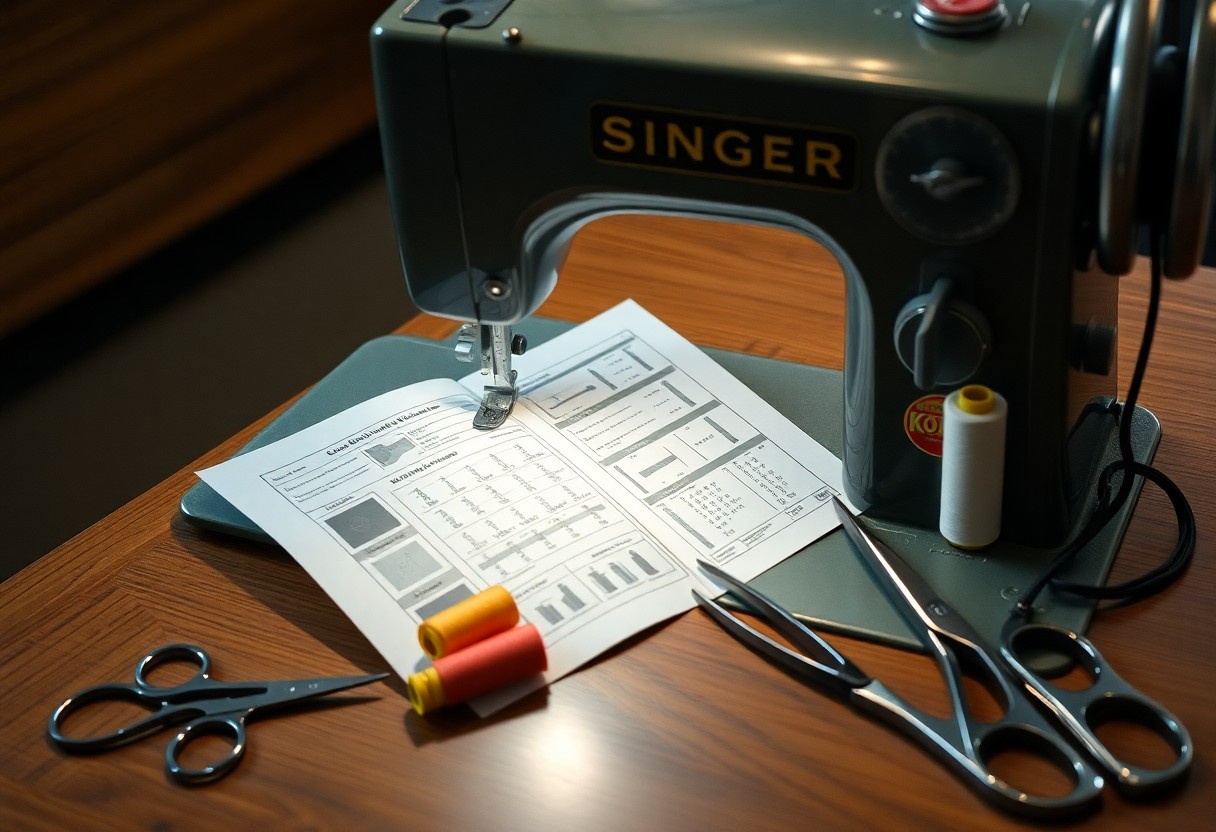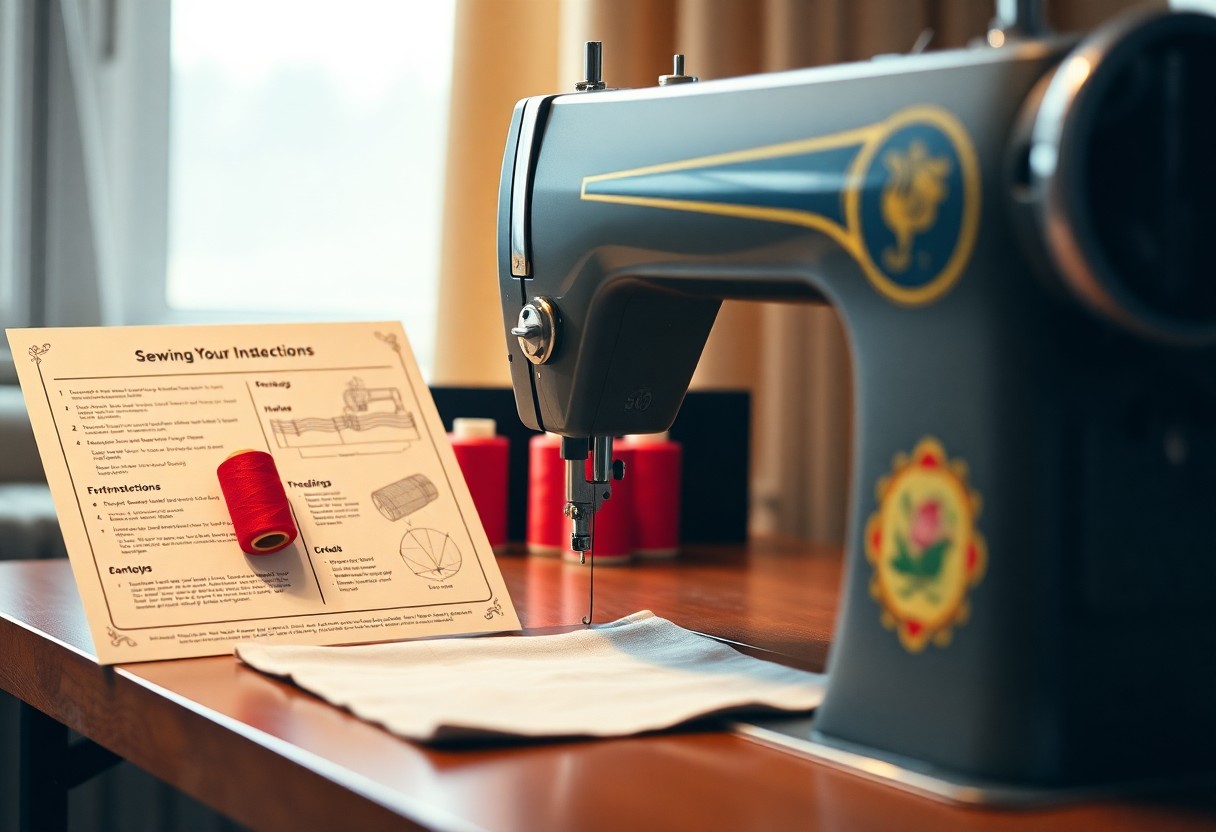As a beginner, you may find threading the Singer 301 a bit daunting, but with this guide, you’ll learn step-by-step techniques to simplify the process. Understanding how to properly thread your machine will not only ensure smooth operation but also boost your confidence as you initiate on your sewing journey. Stay tuned for vital tips and tricks to avoid pitfalls and make your experience enjoyable, paving the way for your creative projects.
Key Takeaways:
- Familiarize yourself with the necessary components of the Singer 301 to make the threading process smoother.
- Follow step-by-step instructions for threading, ensuring you keep tension settings in mind for optimal performance.
- Practice threading multiple times to build confidence and improve your sewing skills over time.
The Anatomy of Your Singer 301
Understanding the anatomy of your Singer 301 is crucial in mastering its functionality. This classic machine boasts several key components, including the needle, presser foot, feed dogs, tension dial, and spool pin. Each part plays a significant role in the sewing process, ensuring smooth operation and optimal results. Familiarizing yourself with these components will make threading and adjusting your machine much easier as you commence on your sewing journey.
Key Components and Their Functions
The Singer 301 comes equipped with vital components that enhance your sewing experience. The needle is responsible for piercing the fabric, while the presser foot holds the fabric in place as you sew. Feed dogs move the fabric under the needle, allowing for consistent stitching. The tension dial adjusts the tension of the thread for even stitches, and the spool pin holds the thread spool, providing a steady supply of thread as you sew.
The Importance of Familiarization
Becoming well-acquainted with your Singer 301’s components simplifies your sewing tasks significantly. Knowing where each part is located and its function reduces the likelihood of errors during threading and operation. You will save time and frustration down the line by identifying which adjustments may be needed for different sewing projects. For instance, understanding the tension dial’s impact on fabric type allows you to achieve perfect stitching every time. Exploring your machine’s manual can also provide additional insights into its capabilities, ensuring you make the most of your new sewing companion.

Threading Techniques: Step-By-Step
Preparing Your Machine for Threading
Before threading your Singer 301, ensure the machine is in the proper state. Start by turning the handwheel towards you to raise the needle to its highest point. This position allows for easier access to the threading path. Additionally, raise the presser foot to open the tension disks, ensuring your thread can pass through freely. Lastly, remove any old thread and check the needle and bobbin for proper installation and condition. A clean start sets you up for success.
The Correct Order for Threading
Threading your Singer 301 requires adherence to a specific order for optimal function. The general sequence involves threading the upper tension first, guiding through the thread guide, and then threading the needle. Each step is designed to ensure that the thread travels smoothly and without obstruction. Following this order not only prevents potential tangling or skipping stitches but also enhances your overall sewing experience.
The proper order for threading is key to ensuring that the machine operates efficiently. Start by placing the spool of thread on the spool pin, then guide the thread through the upper tension mechanism, and slide it into the thread guide. Next, bring it down through the tension disks before routing it around the take-up lever and finally threading the needle from front to back. This sequential approach is designed to maintain consistent tension and fabric control, thus producing better, more reliable stitching on your projects.
Common Threading Pitfalls to Avoid
A common problem when threading your Singer 301 involves overlooking certain steps or making small mistakes that lead to major headaches. It’s vital to be aware of these pitfalls, as they can result in tangled threads, skipped stitches, or even jammed machines. Being mindful of the correct threading order and the path of the thread can make all the difference in achieving smooth sewing. Practicing consistency in your approach will build your confidence and help you avoid frustration.
Missteps That Can Jam Your Machine
Troubleshooting Common Mistakes

Mastering the Tension: Getting the Right Balance
Understanding thread tension is key to achieving stitching success with your Singer 301. Proper tension ensures even stitches, whether you’re sewing lightweight silk or heavy denim. Too tight or too loose tension can lead to puckering or thread breaking, which ultimately affects your project’s overall aesthetic. You’ll soon learn that adjusting tension is part of your creative process and imperative for any sewing enthusiast aiming for professional results.
How Tension Affects Your Stitch Quality
Stitch quality directly correlates with tension settings. If the tension is too high, your threads may pull too tightly, causing unsightly puckers. Conversely, too little tension leads to loose, sloppy seams. By monitoring the balance of upper and lower tension, you can achieve a consistent stitch appearance that enhances both strength and visual appeal.
Adjusting Tension for Different Fabrics
Each fabric type demands specific tension settings to maintain your desired stitch quality. For example, thicker fabrics like canvas or denim benefit from a looser tension, while lighter fabrics such as chiffon require a tighter setting to keep stitches secure. Balancing these tensions allows your sewing machine to perform optimally across various materials.
When working with different fabrics, adjusting tension is not just about the thickness; it’s also related to the stretch and texture. For instance, stretchy fabrics like jersey often need slightly lower tension to accommodate movement, preventing skipped stitches. On the other hand, heavily textured materials might require a tighter tension to achieve a clean finish. Experimenting with a few test stitches on scrap pieces of each fabric can help you find the perfect setting before plunging into your main project.
Finishing Touches: Maintenance and Care
To keep your Singer 301 running smoothly, regular maintenance is crucial. Cleaning out lint and dust after every few projects will prevent buildup that can affect performance. Additionally, oiling the moving parts as recommended in the manual ensures everything operates seamlessly. When you prioritize care, you’re investing in durability and efficiency; consistent attention makes your sewing sessions enjoyable and trouble-free.
Ensuring Longevity of Your Singer 301
Maintaining the Singer 301 isn’t just about fixing immediate issues; it’s about implementing practices that extend its lifespan. Make it a habit to clean the machine, replace needles when dull, and use quality thread to reduce strain and wear. Your proactive approach will not only keep the machine in optimal condition but also enhance your sewing experience.
Routine Checks to Keep Threading Smooth
Regular inspections can prevent headaches during sewing sessions. Check the condition of your needles, ensuring they are sharp and suitable for the fabric type. Additionally, keep an eye on the thread path, looking for any tangles or frays in the thread. A quick visual inspection before starting a project saves you from potential frustration, ensuring you’re always ready to create.
Incorporating routine checks means dedicating a few moments before each sewing session to ensure that your machine is in impeccable shape. This includes checking if the presser foot is functioning correctly, ensuring the thread is seated properly in the tension discs, and confirming that bobbin is wound evenly. Making these quick assessments will significantly reduce the chance of threading issues, allowing for a smoother workflow. By being diligent about these small tasks, you set the stage for successful and enjoyable sewing adventures.
Final Words
Considering all points, you now have a solid understanding of how to thread the Singer 301 with confidence. By following the step-by-step instructions and familiarizing yourself with the machine’s components, you will find that threading becomes a straightforward task. Your newfound skills will not only enhance your sewing experience but also empower you to tackle various projects with ease. Embrace the journey of sewing, and enjoy the creative possibilities that await you!
FAQ
Q: What is the first step to take when threading the Singer 301?
A: The first step in threading your Singer 301 sewing machine is to prepare the machine by ensuring that it is turned off and unplugged for safety. Then, raise the presser foot lever to release tension on the thread. Begin by placing your spool of thread on the spool pin, ensuring it is seated correctly. Follow the threading path indicated on the machine, which usually includes threading the thread through a series of guides and down the tension mechanism. The sequential movement through these guides is crucial for smooth operation.
Q: How do I ensure that the thread is properly seated in the tension disc?
A: Proper seating of the thread in the tension disc is important for balanced stitches. After you have threaded the machine according to the threading diagram, gently pull the thread to verify if it moves freely. If it feels too loose or tight, it may not be seated correctly. To ensure proper seating, you can utilize a slight tug, which should engage the tension mechanism without feeling overly resistive. Adjust the position of the thread if needed, and repeat this process until the tension feels appropriate for sewing.
Q: What should I do if the thread keeps breaking while I sew?
A: If you experience thread breaks while sewing with your Singer 301, there are several troubleshooting steps to consider. First, check if the thread is of good quality and not old or damaged. Next, ensure that you are using the correct needle type and size for your fabric. A needle that is too large or too small can cause thread breakage. Additionally, re-examine the threading path to ensure that the thread is not snagging on any edges or guides. Lastly, inspect the bobbin to make sure it is wound correctly and inserted properly—an improperly filled bobbin can also lead to thread issues.
